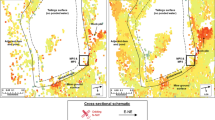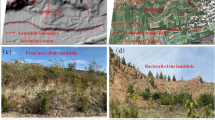Abstract
On February 22, 2023, a devastating landslide occurred on the mining slope of an open-pit coal mine in Inner Mongolia, China, leading to the mining area being buried and 53 fatalities. The source area of the landslide measured approximately 500 m in both length and width, with an estimated volume of the deposited material reaching approximately 5 million cubic metres. Based on the severe impact of this incident, our study conducted preliminary research using a combination of methodologies, including particle image analysis, synthetic aperture radar interferometry, interpretation of optical remote sensing data, and post-event news reports analysis. The results indicated that the landslide lasted 23 s from initiation to cessation of movement. The historical deformation indicated that prior to the resumption of the mining activities, only localized deformation was observed at the rear edge of the landslide. However, when mining activities resumed in April 2021 and extended to the vicinity of the north slope, the deformation range and rate in the source area of the landslide rapidly increased. The investigation deduced that the soft foundation at the slope bottom and mining activities are the primary causative factors of this event. Mining activities, which stripped coal seams within the slope and surface rock masses, led to the expansion of tension cracks within the landslide body, weakening resisting forces at the leading edge and thus playing a significant role in destabilizing the landslide body. The evolution of the landslide from incubation to instability could be divided into four stages: early microcrack development, slow creep, accelerated deformation after resumption of mining, and ultimate instability. Therefore, it is of great significance to advance real-time deformation monitoring and early warning systems specifically those designed for mining slope areas by comprehensive measures. Furthermore, enhancing the high-frequency monitoring capabilities of synthetic aperture radar satellites is crucial to reducing the occurrence of these catastrophic events.














Similar content being viewed by others
Data availability
The datasets generated and/or analyzed during the current study are available from the corresponding authors upon reasonable request.
References
Berardino P, Fornaro G, Lanari R et al (2002) A new algorithm for surface deformation monitoring based on small baseline differential SAR interferograms. IEEE Trans Geosci Remote Sens 40:2375–2383. https://doi.org/10.1109/TGRS.2002.803792
Bilal M, Xing A, Zhuang Y et al (2021) Coupled 3D numerical model for a landslide-induced impulse water wave: a case study of the Fuquan landslide. Eng Geol 290:106209. https://doi.org/10.1016/j.enggeo.2021.106209
Carlà T, Farina P, Intrieri E et al (2017) On the monitoring and early-warning of brittle slope failures in hard rock masses: examples from an open-pit mine. Eng Geol 228:71–81. https://doi.org/10.1016/j.enggeo.2017.08.007
Carlà T, Farina P, Intrieri E et al (2018) Integration of ground-based radar and satellite InSAR data for the analysis of an unexpected slope failure in an open-pit mine. Eng Geol 235:39–52. https://doi.org/10.1016/j.enggeo.2018.01.021
Chen H, Zhao C, Li B et al (2023) Monitoring spatiotemporal evolution of Kaiyang landslides induced by phosphate mining using distributed scatterers InSAR technique. Landslides 20:695–706. https://doi.org/10.1007/s10346-022-01986-5
Chen L, Zhao C, Kang Y et al (2020) Pre-event deformation and failure mechanism analysis of the pusa landslide, China with multi-Sensor SAR imagery. Remote Sens 12:856. https://doi.org/10.3390/rs12050856
Chen M, Tomás R, Li Z et al (2016) Imaging land subsidence induced by groundwater extraction in Beijing (China) using satellite radar interferometry. Remote Sens 8:468. https://doi.org/10.3390/rs8060468
Dai F, Lee C, Ngai Y (2002) Landslide risk assessment and management: an overview. Eng Geol 64:65–87. https://doi.org/10.1016/s0013-7952(01)00093-x
Feng C, Li S, Liu X, Zhang Y (2014) A semi-spring and semi-edge combined contact model in CDEM and its application to analysis of Jiweishan landslide. J Rock Mech Geotech Eng 6:26–35. https://doi.org/10.1016/j.jrmge.2013.12.001
Guo C, Zhang Y, Li X et al (2019) Reactivation of giant Jiangdingya ancient landslide in Zhouqu County, Gansu Province, China. Landslides 17:179–190. https://doi.org/10.1007/s10346-019-01266-9
Hain R, Kähler C (2007) Fundamentals of multiframe particle image velocimetry (PIV). Exp Fluids 42:575–587. https://doi.org/10.1007/s00348-007-0266-6
Hungr O, Leroueil S, Picarelli L (2013) The Varnes classification of landslide types, an update. Landslides 11:167–194. https://doi.org/10.1007/s10346-013-0436-y
Intrieri E, Carlà T, Farina P et al (2019) Satellite interferometry as a tool for early warning and aiding decision making in an open-pit mine. IEEE J Sel Top Appl Earth Obs Remote Sens 12:5248–5258. https://doi.org/10.1109/JSTARS.2019.2953339
Lai Q, Zhao J, Shi B et al (2023) Deformation evolution of landslides induced by coal mining in mountainous areas: case study of the Madaling landslide, Guizhou, China. Landslides 20:2003–2016. https://doi.org/10.1007/s10346-023-02069-9
Lehmkuhl F, Stauch G (2023) Anthropogenic influence of open pit mining on river floods, an example of the Blessem flood 2021. Geomorphology 421:108522. https://doi.org/10.1016/j.geomorph.2022.108522
Li Q, Zhang C (2021) Damage conduction model of high intensity mining in western mining area based on conservation of mining space and its application. J Min Saf Eng 38:1–8. https://doi.org/10.13545/j.cnki.jmse.2019.0494
Li W, Zhan W, Lu H et al (2023) Precursors to large rockslides visible on optical remote-sensing images and their implications for landslide early detection. Landslides 20:1–12. https://doi.org/10.1007/s10346-022-01960-1
López-Vinielles J, Ezquerro P, Fernández-Merodo J et al (2020) Remote analysis of an open-pit slope failure: Las Cruces case study, Spain. Landslides 17:2173–2188. https://doi.org/10.1007/s10346-020-01413-7
Ma G, Hu X, Yin Y et al (2018) Failure mechanisms and development of catastrophic rockslides triggered by precipitation and open-pit mining in Emei, Sichuan, China. Landslides 15:1401–1414. https://doi.org/10.1007/s10346-018-0981-5
Meng Q, Li W, Raspini F et al (2021) Time-series analysis of the evolution of large-scale loess landslides using InSAR and UAV photogrammetry techniques: a case study in Hongheyan, Gansu Province, Northwest China. Landslides 18:251–265. https://doi.org/10.1007/s10346-020-01490-8
Pirasteh S, Shamsipour G, Liu G et al (2020) A new algorithm for landslide geometric and deformation analysis supported by digital elevation models. Earth Sci Inform 13:361–375. https://doi.org/10.1007/s12145-019-00437-5
Pu C, Xu Q, Wang X et al (2023) Refined mapping and kinematic trend assessment of potential landslides associated with large-scale land creation projects with multitemporal InSAR. Int J Appl Earth Obs Geoinformation 118:103266. https://doi.org/10.1016/j.jag.2023.103266
Raffel M, Willert CE, Scarano F et al (2018) Particle image velocimetry: a practical guide. Springer, Heidelberg
Roy P, Martha T, Khanna K et al (2022) Time and path prediction of landslides using InSAR and flow model. Remote Sens Environ 271:112899. https://doi.org/10.1016/j.rse.2022.112899
Saito M, Uezawa H (1961) Failure of soil due to creep. In: Proceedings of the 5th International Conference on Soil Mechanics and Foundation Engineering. 1: 315–318
Saito M (1965) Forecasting the time of occurrence of a slope failure. In: Proceedings of the 6th International Mechanics and Foundation Engineering pp: 537–541
Salmi EF, Nazem M, Karakus M (2017) Numerical analysis of a large landslide induced by coal mining subsidence. Eng Geol 217:141–152. https://doi.org/10.1016/j.enggeo.2016.12.021
Wang X, Xiao Y, Shi W et al (2022) Forensic analysis and numerical simulation of a catastrophic landslide of dissolved and fractured rock slope subject to underground mining. Landslides 19:1045–1067. https://doi.org/10.1007/s10346-021-01842-y
Westerweel J (1997) Fundamentals of digital particle image velocimetry. Meas Sci Technol 8:1379–1392. https://doi.org/10.1088/0957-0233/8/12/002
Williams C, Ross B, Zebker M et al (2021) Assessment of the available historic RADARSAT-2 synthetic aperture radar data prior to the Manefay slide at the Bingham Canyon mine using modern InSAR techniques. Rock Mech Rock Eng 54:3469–3489. https://doi.org/10.1007/s00603-021-02483-2
Xing H, Zhang Q, Braithwaite C et al (2017) High-speed photography and digital optical measurement techniques for geomaterials: fundamentals and applications. Rock Mech Rock Eng 50:1611–1659. https://doi.org/10.1007/s00603-016-1164-0
Zaruba Q, Mencl V (1976) Engineering geology. Elsevier, Amsterdam
Zhang B, Wang R, Deng Y et al (2019) Mapping the Yellow River Delta land subsidence with multitemporal SAR interferometry by exploiting both persistent and distributed scatterers. ISPRS J Photogramm Remote Sens 148:157–173. https://doi.org/10.1016/j.isprsjprs.2018.12.008
Zhang S, Shi W, Yang C et al (2022) Experimental evaluation of gentle anti-dip slope deformation and fracture network under the action of underground mining. Landslides 20:381–408. https://doi.org/10.1007/s10346-022-01976-7
Zhao J, Ma Y, Lin B et al (2016) Geomechanical mode of mining landslides with gently counter-inclined bedding-a case study of Madaling landslide in Guizhou Province. Chin J Rock Mech Eng 35:2217–2224. https://doi.org/10.13722/j.cnki.jrme.2016.0106
Acknowledgements
We express our gratitude to European Space Agency (ESA) for providing us with free access to Sentinel-1 datasets through the Sentinels Scientific Data Hub, and we also express our gratitude to the Planet Explorer for their provision of freely available daily updated optical imagery, which has been instrumental in aiding the interpretation of geomorphic changes.
Funding
This research is supported by the National Key Research and Development Program of China (Grant No. 2021YFC3000401), the National Key Research and the National Natural Science Foundation of China (Grant No. 41941019), the Key Research and Development Program of Sichuan Province (Grant No. 2023YFS0435), the Yangtze River Joint Research Phase II Program (Grant No. 2022-LHYJ-02–0201), and the State Key Laboratory of Geohazard Prevention and Geoenvironment Protection Independent Research Project (Grant No. SKLGP2022Z007).
Author information
Authors and Affiliations
Corresponding authors
Ethics declarations
Conflict of interest
The authors declare no competing interests.
Supplementary Information
Below is the link to the electronic supplementary material.
Zusatzmaterial 1 (MP4 9368 KB)
Rights and permissions
Springer Nature or its licensor (e.g. a society or other partner) holds exclusive rights to this article under a publishing agreement with the author(s) or other rightsholder(s); author self-archiving of the accepted manuscript version of this article is solely governed by the terms of such publishing agreement and applicable law.
About this article
Cite this article
Li, Z., Li, W., Xu, Q. et al. Preliminary analysis of the catastrophic February 22nd 2023 Xinjing open-pit mine landslide, Inner Mongolia, China. Landslides 21, 1053–1067 (2024). https://doi.org/10.1007/s10346-024-02229-5
Received:
Accepted:
Published:
Issue Date:
DOI: https://doi.org/10.1007/s10346-024-02229-5




